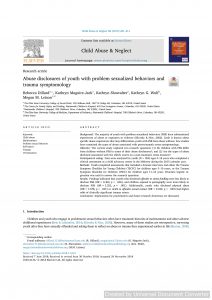Child-on-child (Peer-on-peer) Sexual Abuse
Abuse Disclosures of Youth with Problem Sexualized Behaviors and Trauma Symptomology
 Full Article Name: Abuse Disclosures of Youth with Problem Sexualized Behaviors and Trauma Symptomology
Full Article Name: Abuse Disclosures of Youth with Problem Sexualized Behaviors and Trauma Symptomology
Open Access: No
Abstract
Background The majority of youth with problem sexualized behaviors (PSB) have substantiated experiences of abuse or exposures to violence (Silovsky & Niec, 2002). Little is known about specific abuse experiences that may differentiate youth with PSB from those without. Few studies have examined the types of abuse associated with post-traumatic stress symptomology.
Objective The current study explored two research questions: (1) Do children with PSB differ from children without PSB in terms of their abuse disclosures?; and (2) Are the types of abuse disclosed associated with the child’s scores on a post-traumatic stress measure?.
Participants & setting Data were analyzed for youth (N = 950) ages 3–18 years who completed a clinical assessment at a child advocacy center in the Midwest during the 2015 calendar year.
Methods Youth completed assessments that included a forensic interview and either the Trauma Symptom Checklist for Young Children (TSCYC) for children ages 3–10 years, or the Trauma Symptom Checklist for Children (TSCC) for children ages 11–16 years. Bivariate logistic regression was used to answer the research questions.
Results Findings indicated that youths who disclosed offender to victim fondling were less likely to disclose PSB (OR=0.460, p= .026), and children exposed to pornography were more likely to disclose PSB (OR=3.252, p= .001). Additionally, youth who disclosed physical abuse (OR=1.678, p= .001) or victim to offender sexual contact (OR=2.242, p= .003) had higher odds of clinically significant trauma scores.
Conclusions Implications for practitioners and future research directions are discussed.
Relevance
“Prior research has shown that early exposure to pornography is a risk factor predictive of later sexual crime in adolescence…The strength of the relationship found between pornography and problem sexual behaviors in children in the present study suggests that the same may be true for younger children.”
Citation
Dillard, R., Maguire-Jack, K., Showalter, K., Wolf, K. G., & Letson, M. M. (2019). Abuse disclosures of youth with problem sexualized behaviors and trauma symptomology. Child Abuse & Neglect, 88, 201–211. https://doi.org/10.1016/j.chiabu.2018.11.019

